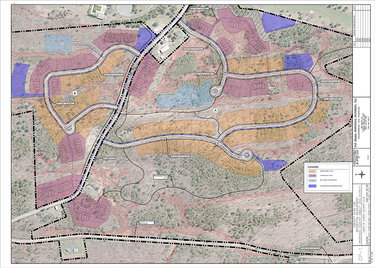Guilderland accepts Albany Country Club’s application for a rezone
— From Albany Country Club’s submittal to the town of Guilderland
The Guilderland Town Board on Dec. 6 accepted Albany Country Club’s rezone application that would allow for 116 townhomes, 88 single-family homes, and 50 condominiums. Accepting the application is the first step in the Country Hamlet process, explained Town Planner Kenneth Kovalchik, saying that it “has nothing to do with approving the application.”
GUILDERLAND — In what was described as the first step of many, the Guilderland Town Board on Dec. 6 accepted Albany Country Club’s application to rezone its property to allow for a 254-unit development.
“Accepting is not the same thing as approving,” explained Supervisor Peter Barber.
The club is seeking to build 254 units:
— 88 single-family homes located on about 27 acres;
— 116 townhomes on about 23 acres; and
— 50 condominiums on about 4 acres.
Albany Country Club wants to rezone around half of its 800-plus acres from rural agricultural and residential to that of a Country Hamlet District. Guilderland’s Country Hamlet zoning requirements include a minimum of 160 acres to be included in any development proposal of which 60 percent must be preserved as open space.
The first step in the Country Hamlet process, explained Town Planner Kenneth Kovalchik on Dec. 6, is for the town board to officially accept the application, which “has nothing to do with approving the application,” he said.
The Country Hamlet review process, Kovalchik said, follows the town’s Planned Unit Development review process, meaning the town board is the lead agency and will make the ultimate decision to approve or deny the application.
The planning board will act as the site-plan review body for the town, he said.
The project, Kovalchik said, will go back and forth multiple times between the two boards during the review — for sketch plan review, preliminary site-plan approval, and final site-plan approval.
The town board will also act as the project’s SEQR agency, meaning anything related to State Environmental Quality Review, which looks at environmental impacts and how they can be mitigated, will be dealt with by the town board.
“So it’ll be a lengthy process, multiple times in front of the town board, multiple times in front of the planning board,” Kovalchik said.
The proposal meets the criteria of a Type I State Environmental Quality Review Act action, meaning its construction would likely have a significant adverse impact on the environment. In his memo to the town board, Kovalchik recommended that, if the town board accepted lead-agency status on Dec. 6, it begins a SEQR coordinated review process. During the coordinated review process, any of the involved agencies will have the opportunity to say that they want to be the lead agency.
Coordinated review typically takes about 30 days, he said, during which time the planning board begins its sketch-plan review.
Since this is a Type I action, the board will have to decide whether to make a positive or negative SEQR declaration, Kovalchik explained, and cited as an example Pyramid’s recent projects near Crossgates Mall.
“The planning board did what’s called a positive declaration. By that, the lead agency is then required to do an environmental impact statement,” Kovalchik explained, then pivoted back to the present. “The lead agency has to make a determination on whether they believe this project by the Albany Country Club, based on its impacts, could potentially have cumulative impacts that should be more thoroughly addressed.”
With the town board accepting the application, it will now be referred to the planning board to start the sketch-plan review.
ACC presents
James Harris, president of Albany Country Club, told the board the club just celebrated its 132nd birthday, and that it’s among the 10 oldest country clubs in the United States.
Sometime in the ’60s, the board and some members of the club bought over two dozen plots of land where the current Albany Country Club now sits. At one point, Harris said, the club owned about 1,400 of its surrounding acres; it now has about 860.
He said the club employs about 165 people at peak; has a payroll over $2 million; and is the the sixth largest payer of school taxes in Voorheesville. He also noted in a recent newsletter that the club is “saddled with debt.”
Thomas Cullinan, the club’s point person on the project for the past half-decade or so, told town board members that housing had been proposed at Albany Country Club for a number of years. “We have had many dance partners, if you will,” he said, from plans for Weatherfield’s 82-acre fourth phase to “the big Toll Brothers proposal in 2010, which basically said we’re going to take all the property and develop it.”
But, Cullinan said, the Toll Brothers proposal “never went very far, was never really an earnest proposal. But we did entertain and spend time on it.” In the past five to seven years, though, there have been a number of discussions with local developers, which is how the club met its current project partner and engineer, Ivan Zdrahal.
Cullinan noted that, when the project team met with the town in 2019, the now-254-unit proposal was for over 300 units and the development “stretched all the way down to Grant Hill Road,” with housing proposed on a Relyea Road parcel that the club is now proposing for donation to the town as parkland.
Wade Newman, an engineer with Zdrahal, offered board members some of the project’s more technical details.
Newman said, after accounting for wetlands and other constrained spaces, it was determined that the project had about 256 acres of buildable land, which meant an allowable base density of 205 units, “which you get by multiplying the buildable land by the allowable unit density of 0.8 units per acre.”
As part of the Country Hamlet district development, Newman said, “There is an allowance for a density bonus based on a few different criteria.”
Newman said there were three criteria the project team felt its proposal met to receive a density bonus:
— The total open space area being conserved is greater than 75 percent of the overall project, 82.7 percent;
— There are public water supply improvements proposed; and
— Off-site pedestrian linkages are proposed.
The bonuses, Newman said, bump the project up to 254 units.
Newman also noted there would be improvements made to the current sewage system, which needs monthly maintenance from town employees.
Board requests
Barber sought assurances from Albany Country Club that its proposal would be bike and pedestrian friendly.
“I appreciate we just said about a willingness to work, you know, with the town. What I’m just wondering is, would you actually put that on the map? You know, put a note … I’m not looking for sidewalks, necessarily, or bike paths,” Barber said. “I’m just looking for an acknowledgement on the site plan if we were to refer this to the planning board. So it’s clear, you know, that there’ll be some consideration of what’s appropriate, bicycle or pedestrian connections, basically for [Route] 155 up … to the town park.”
Barber said he wasn’t going to hold up the project, but he also didn’t feel comfortable sending it to the planning board until the issue was addressed.
Councilwoman Rosemary Centi hit on a concern for every proposal that comes before the town board. “Every project that comes before the board, water and sewer is an issue, particularly water is very costly,” Centi said, and Guilderland gets its water from Rotterdam and Albany, the latter “at a considerable cost,” so “it’s always an issue,” she said.
Centi said she’d like to hear what Timothy McIntyre, the town’s superintendent of water and wastewater management, had to say on the matter.
Project attorney Donald Zee, responding to Barber’s request for a note on the site plan, tried to talk about all the other things Albany Country Club was doing for the town. Zee noted water, sewer, and an unforeseen electrical upgrade would run over $4 million in 2018 dollars, noting there has been inflation, which according to the Bureau of Labor Statistics would close to $714,000 to the 2018 estimate.
The board was unmoved.
But, after some more back-and-forth, Albany Country Club agreed to put a note on the site plan, and the town board agreed to accept the application.



